new posts in all blogs
Viewing: Blog Posts Tagged with: Evan Turk, Most Recent at Top [Help]
Results 1 - 6 of 6
How to use this Page
You are viewing the most recent posts tagged with the words: Evan Turk in the JacketFlap blog reader. What is a tag? Think of a tag as a keyword or category label. Tags can both help you find posts on JacketFlap.com as well as provide an easy way for you to "remember" and classify posts for later recall. Try adding a tag yourself by clicking "Add a tag" below a post's header. Scroll down through the list of Recent Posts in the left column and click on a post title that sounds interesting. You can view all posts from a specific blog by clicking the Blog name in the right column, or you can click a 'More Posts from this Blog' link in any individual post.

By:
Betsy Bird,
on 7/12/2016
Blog:
A Fuse #8 Production
(
Login to Add to MyJacketFlap)
JacketFlap tags:
Pat the Bunny,
Fusenews,
Mazza Museum,
Little Free Library,
sassy clocks,
children's literature conferences,
Evan Turk,
New Podcast Alert,
British picture books,
Brexit,
Christine Inzer,
Dr. Carla Hayden,
Joanna Rudge Long,
Lady Elaine Fairchilde,
J.K. Rowling,
Mitali Perkins,
NYPL,
Lois Duncan,
Where's Waldo?,
Add a tag
Hi, folks. Haven’t done one of these in a while. Let’s see what there is to see.
If I’m feeling nostalgic for NYC this week there’s little wonder. Whether it’s an article on many library branches’ secret apartments (I visited 8-10 of them in my day and someday a clever photographer should do a series on them) or New York Magazine’s (justifiable) kvetching over the new Donnell, it’s like I’m there again.
Speaking of kvetching, this article about My Little Free Library War is amusing. When I was leaving the aforementioned NYC I found I had too many books. The solution? Daily trips to the local Little Free Library. I’d fill them up one day and then come back the next with more. I don’t care what anyone did with them. That box was like Mary Poppins’ carpetbag.

Waldo’s cool with it. He doesn’t mind sharing the spotlight.
As for my current town, how cute is this? Our downtown is doing a Where’s Waldo / Where’s Warhol scavenger hunt. It all begins at the wonderful bookstore Bookends and Beginnings and goes from there.
This next piece is fantastic and I’ve never seen anything quite like it before. A British children’s literature blogger comes to America. Walks into a Barnes and Noble. Immediately she is struck by the massive differences between how a major British chain (like Waterstones) sells children’s books vs. how and American chain (B&N) does it. She writes up the differences in the post Picture book differences between the main bookshop chains in the US and UK – Paeony Lewis. What struck me as particularly interesting is the emphasis the author makes on how American bookstores don’t promote and sell paperbacks to the same degree that the British stores do. As a result, our books are more expensive. What are the greater repercussions of this? Fantastic read.
I got the following message from ALA last week and figured this was a good place to share. Ahem:
Now is the Best Time to Help Dr. Carla Hayden Become Librarian of Congress
The American Library Association (ALA) is urging the library community to contact their U.S. senators (before they adjourn next week) to encourage them to confirm Dr. Carla Hayden to become the next Librarian of Congress. This is the first time in more than 60 years that a librarian is poised to take on this role. ALA offers these talking points. Visit the ALA Legislative Action Center to email your senators, contact them on Twitter, or for information on calling your senators.
There’s been a lot of talk about Ms. J.K. Rowling in the news lately. Specifically, in terms of the international magic schools she’s been introducing. I feel inadequate to speak about them, and fortunately I don’t have to. Monica Edinger has written a great piece called J.K. Rowling’s Unfortunate Attempts at Globalization. A lot of people have focused solely and squarely on the references to Native Americans in the American school. Monica sheds additional light on the African, Japanese, and Brazilian ones, for which I am VERY grateful.
By the way, having problems with J.K. Rowling in this vein is hardly new. You can read Farah Mendelsohn’s academic paper Crowning the King: Harry Potter and the Construction of Authority from 2001 right now, if you like.
By the way, if you missed Jules Danielson’s interview with Evan Turk over at Seven Impossible Things Before Breakfast, turn right around, leave this blog, and go over there. The art . . . the art . . .
 For a while there I enjoyed a little Reading Too Much Into Picture Books series before my Fuse 8 TV interviews. Very much along the same lines is the recent Salon piece Pat the Bunny Is Kind of Twisted and Other Lessons I Learned from Picture Books. It’s not the same three tropes garbled over and over again. There’s a lot of smart stuff being said here. Enjoy!
For a while there I enjoyed a little Reading Too Much Into Picture Books series before my Fuse 8 TV interviews. Very much along the same lines is the recent Salon piece Pat the Bunny Is Kind of Twisted and Other Lessons I Learned from Picture Books. It’s not the same three tropes garbled over and over again. There’s a lot of smart stuff being said here. Enjoy!
Wait, what . . . The Mazza Museum has a summer conference? Why was I not informed? *clap clap* My chariot! The first day is July 18th. There’s still time!
There are many reasons to listen to the NYPL podcast The Librarian Is In. Reason #24601: Check out this simply adorable photograph of a young Lois Duncan.
Hey there! What Nibling just won herself a 2016 South Asia Book Award? Would that be Mitali Perkins for her absolutely fantastic Tiger Boy? Dang right it would! Go, Mitali, go!
Because my day job requires me to keep up with adult literature I read a lot of Publishers Weekly (that sounded like a very earnest television or radio ad for PW, by the way). The other day I was reading its articles on what Brexit is going to mean for the literary world, and I briefly toyed with the notion of doing a blog post on what it would mean for the children’s literary world. I decided not to pursue this idea since I know next to nothing about the topic and while that normally wouldn’t stop me, Phil Nel did it best anyway. Check out his piece Children’s Lit VS Brexit.
Curious about the Boston Globe-Horn Book Award? Want to know more about it? Interested in reading an interview with a woman who would visit Anne Carroll Moore in the library as a child? You can get all that and more with this interview with this year’s BGHB committee chair Joanna Rudge Long.
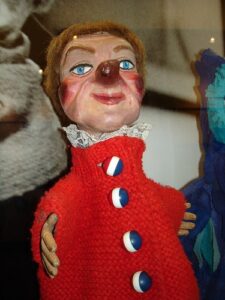 Um… so this one has nothing to do with children’s books and everything to do with my own childhood. Basically, if you’ve been waiting for an article to justify Lady Elaine Fairchilde as the feminist icon she truly was, your prayers have been answered. Extra Bonus: Check out the perhaps indeed legit comment from Lady Aberline. Or read my piece on the new Lady Elaine. Clearly this is a trope in my life.
Um… so this one has nothing to do with children’s books and everything to do with my own childhood. Basically, if you’ve been waiting for an article to justify Lady Elaine Fairchilde as the feminist icon she truly was, your prayers have been answered. Extra Bonus: Check out the perhaps indeed legit comment from Lady Aberline. Or read my piece on the new Lady Elaine. Clearly this is a trope in my life.
Just want to give a shout-out to Christine Inzer, the self-published teen graphic novelist whose book Halfway Home was reviewed here in 2014. Christine got herself a real publisher and her new book just earned a stellar review from Publishers Weekly. Yay, Christine!
New Podcast Alert: In case you are unfamiliar with it, The Writing Barn is the brainchild of Owner & Creative Director, Bethany Hegedus, and offers writers “ways of deepening their process and perfecting their craft, whether they travel cross-town or across the country to our retreat and workshop venue”. Now Bethany has created Porchlight, a podcast that interviews the Barn’s guests as well as folks in the world at large. You know I’ll be listening.
Daily Image:
Best. Library. Clock. Ever.
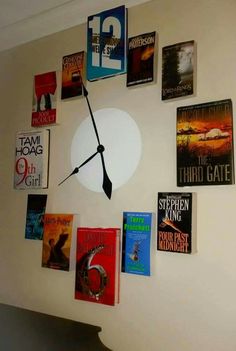
Seriously, I want to do this with picture books. If not in my library then in my home. I should solicit the right titles, though. Hmmm…
Suggestions welcome.


By:
Betsy Bird,
on 7/2/2016
Blog:
A Fuse #8 Production
(
Login to Add to MyJacketFlap)
JacketFlap tags:
Evan Turk,
Videos,
video games,
book trailers,
Newbery Award,
Matt Phelan,
Caldecott Award,
summer slide,
Ellen,
Video Sunday,
illustrator videos,
author videos,
Frank Viva,
I Want My Hat Back,
Add a tag
Aww. Didja miss these? It’s not like I see as many videos these days, y’know. Not for lack of interest. They just don’t float in front my nose the way they used to. Fortunately there are a couple that I’ve collected in my travels and I’m featuring them here today. They may be a bit old. You may have seen them 100 times before. But what the hey, right? Life is short.
First up, ALSC released the Newbery/Caldecott/Wilder reaction videos. Grab your popcorn and enjoy:
I just saw this next trailer online (thank you, Monica!) and I cannot convey to you the avarice I hold for anyone who has already seen this. It’s Matt Phelan’s latest. And it’s gorgeous:
Another trailer to follow. True, the violin brings to mind a kind of Ken Burns-y feel. Not that there’s anything wrong with that.
A couple months ago young Marley Dias put out the call for middle grade black girl books. I missed the fact that she appeared on Ellen. Problem alleviated!

Thanks to Rita Williams-Garcia for the link.
I do not wish to take away from Travis Jonker his drop dead amazing compilation of peculiar I WANT MY HAT BACK videos he compiled. So I will just put one here and tell you to go to his site to see the rest.
This does my little 1984 heart good.
It’s summer. Everyone’s making summer reading videos. This is my library’s. My superintendent is sitting on a slide (at Penny Park, clearly). It gives me great respect for the man. Plus, check out that logo at the end. I hate to say it, guys, but I think my library hosts the most attractive summer reading t-shirt this year.
Hm. That would make a good blog post. . . .
And just to round this all out in a nice way, here’s the book trailer for Evan Turk’s The Storyteller (one of the most beautiful picture books of the year):
Happy 4th of July!


By:
Betsy Bird,
on 3/21/2016
Blog:
A Fuse #8 Production
(
Login to Add to MyJacketFlap)
JacketFlap tags:
Harry Potter,
Beatrix Potter,
A Series of Unfortunate Events,
Kate Greenaway Medal,
Carnegie Medal,
REFORMA,
readalouds,
Bank Street College of Education,
Fusenews,
censorship issues,
Sharyn November,
Evan Turk,
Eric Carle Honors,
New Podcast Alert,
Dana Sheridan,
Add a tag
- We’re diving right in today. Check out this killer poster:
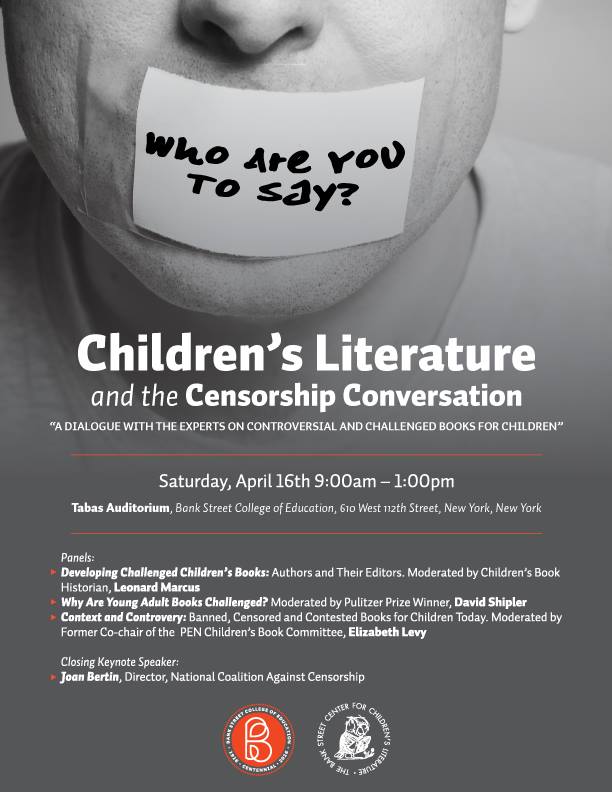
Now if you’re one of the lucky ducks living in NYC, or will be there on the date of 4/16, you now have your marching orders. This is an event held at Bank Street College of Education and in wracking my brains I can’t think of anything more timely. You can see the full listing of the events here. Wish I were there. Go in my stead, won’t you?
- New Podcast Alert: This one sports a catchy moniker that will strike some of you as familiar. Kidlit Drink Night (which would also make a good name for a band, a blog, or a dog) is the official podcast of one Amy Kurtz Skelding. There’s a bit of YA cluttering up the works, but enough children’s stuff is present to make it worth your pretty while. Do be so good as to check it out.
- Hey! Hey hey! The Eric Carle Honorees were named, did you see? And did you notice that amongst them Lee & Low Books was named an Angel? Such fantastic news. A strong year of nominees.
- So Phil Nel shared something recently that I’d like you to note. There is apparently a Tumblr out there called Setup Wizard which consists of the, “Daily Accounts of a Muggle I.T. Guy working at Hogwarts.” Phil suggests reading them in order. I concur. Thanks to Phil for the link.
- I have lots of favorite blogs, but Pop Goes the Page clearly belongs in the upper echelon. Two posts by Dana Sheridan (the Education & Outreach Coordinator of the Cotsen Children’s Library at Princeton University) caught my eye recently. Dana, as you will recall, is responsible for my little toilet paper tube profile picture on Twitter. Well now she’s used her knowledge of all things cardboard to create the world’s most adorable subway system complete with Broadway posters. In a different post Dana, in partnership with The Met Museum’s Nolen Library (the one for the kids), shows a killer display on taking care of your books. It doesn’t necessarily sound interesting, until you see how they magnified a book eating buggy.
- So the other day I’m talking up Evan Turk and his new book The Storyteller, as per usual, and I mention to a librarian that the guy not too long ago did some killer sketches of Chicago blues musicians. Naturally she wanted to see what I was talking about. After all, I practically live in Chicago these days, so if there’s a talented illustrator going about making Chi-town art, it’s well worth promoting. I took her to Evan’s blog and there, beautiful as all get out, is the art. Then I thought I might share it with you as well. This is just a tiny smidgen of what he has up so go to his blog to see more. The sheer talent of it all floors me.
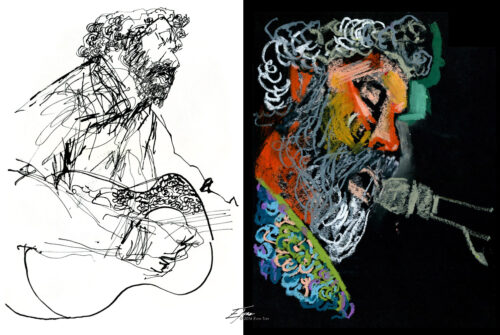
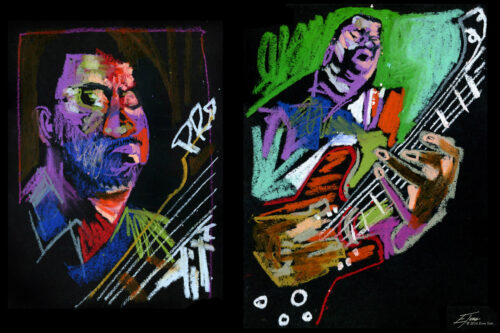
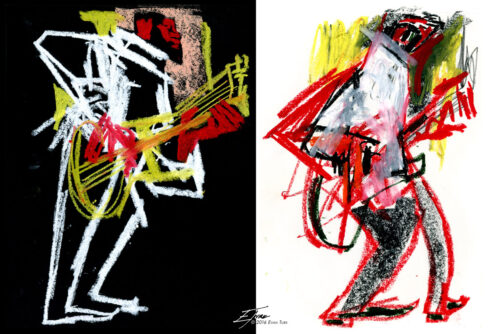
- Do you know who is awesome? Sharyn November, former Viking editor, is awesome. So awesome, in fact, that she has her own brand of tea. You can buy this tea, if you like. I’ll put its description right here:
“sdn tea was created specifically for the punk goddess of children’s publishing, Sharyn November. This deity, who is all sharp angles, quick wit, and extraordinary fashion, is a fiery force of nature–literally and figuratively. She already has her own time zone, so it’s high time she has her own tea. This blend is strong and highly caffeinated. Almost impossibly fruity on the nose, it tastes of warm spice and goes extremely well with a piece of chocolate and a cigarette.”
- Do school librarians yield higher test scores? You may have always suspected that was the case but a recent study out of South Carolina now has some facts so that you can put your money where your mouth is. Are you a school librarian in need of justifying your existence to your employer? You can’t afford not to read this SLJ piece.
- I dunno. I get Neil Patrick Harris playing Count Olaf in the new Netflix series of A Series of Unfortunate Events. That makes sense to me. It’s Dr. Horrible without the songs. Sure. But Patrick Warburton as Snicket? Last time we had Jude Law, and I’m pretty sure that was the right move to make. Puddy as Lemony Snicket seems to lack the right panache.
- In America we have our Newbery and Caldecott Medals. In England it’s all about the Carnegie and Kate Greenaway Awards. And unlike the States, they create shortlists. Those shortlists have just been released for 2016 and (also unlike the States) they nominate books outside their nation. So Canadians like Jon Klassen and Sydney Smith have a fighting chance. I agree with Travis Jonker, though. The alternate title for Sidewalk Flowers was a surprise.
- On the old To Do list: Meet Jan Susina, the Illinois State English Professor who also happens to be an expert on children’s literature. In a recent interview he produced this marvelous mention of Beatrix Potter: “Potter once said, ‘Although nature is not consciously wicked, it is always ruthless.’ Peter Rabbit is a survival story, not a cute bunny story.” How perfectly that quote could have worked in Wild Things. Ah well. The entire interview is well worth your time, particularly his answer to the question, “What is the greatest secret in children’s literature?” The answer will surprise you. Thanks to Phil Nel for the link.
- This Saturday I’ve a Children’s Literary Salon at 2:00. Yet a couple months ago I hosted Jeff Garrett who spoke about his work with the Reforma Children in Crisis Project. You can imagine how pleased I was to hear that ALSC will be donating $5,000 to the project as well. Fantastic news.
I was dumpster diving in the donation bin this week when an old book caught my eye. Hate to say it, but this thing seriously disturbs me. They just don’t make ’em like this anymore (phew!).

Run, girl, run!! Or rather . . . skate, girl, skate!


By:
Betsy Bird,
on 3/1/2016
Blog:
A Fuse #8 Production
(
Login to Add to MyJacketFlap)
JacketFlap tags:
Reviews,
picture books,
Simon and Schuster,
Atheneum,
Best Books,
Evan Turk,
Best Books of 2016,
2016 picture books,
2016 reviews,
Reviews 2016,
original folktale,
Add a tag
 The Storyteller
The Storyteller
By Evan Turk
Atheneum (an imprint of Simon & Schuster)
$24.99
ISBN: 9781481435185
Ages 4-8
On shelves June 28th
Credit the internet age for doing what the television age never could. I don’t know if you’ve noticed, but there is a movement around the world that can be interpreted as nothing so much as a direct response to our digital age. You may have noticed it in small things, like the rise of Steampunk or the sudden surge of interest in Maker stations and the kinds of “hacking” that look suspiciously similar to activities found in shop class in days of yore. All this comes about because people have come to believe that we do not create enough tangible objects in our day-to-day lives anymore. And while this is true, let us not forget that we do not create enough intangible objects either. I’m talking about storytelling, that ancient artform that is currently seeing a worldwide resurgence. It isn’t just the increase in storytelling festivals and podcasts like The Moth here in the States. Young people in countries worldwide are doing what their elders have desired for decades; they’re asking to be told a story. Taking his cues from the newfound interest of young Moroccans in Marrakech in the ancient storytelling tradition, author/illustrator Evan Turk uses the folktale format to craft an original story about storytelling, weaving, history, and language. The end result is a twisty turny story within a story within a story that challenges young readers even as it lures them in.
Once, in the great country of Morocco, storytellers flourished and the cities’ fountains flowed with cool, clear water. As time went on the people became comfortable and forgot about the storytellers, and so they disappeared over the years. So too did the fountains dry up, until one day a boy went looking for some water. What he found instead was an old storyteller. As the man told his tale he would end his story with a story within a story and the boy would find his brass cup filled with liquid. Even as this was happening, however, a desert djinn saw the drought as an opportunity to reclaim the cities that had previously held him back with their fountains. Yet when the djinn was set to level his town, the boy managed to delay him with his storytelling. And as he wove his tale, the people were able to refill their fountains until finally storytelling and water ran freely in the cities once more.
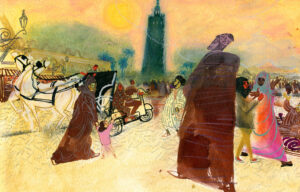 My brain is not what it used to be. Remind me again. What’s that term for a story that tells a story that tells a story that ends only when the innermost story doubles back and each tale is finished in turn? Is there a word such a thing? I suspect that the storytellers amongst us would know. The most obvious similarity to this book that comes to mind is, of course, the tale of Scheherazade. Indeed, the boy uses his stories to trick the djinn. And what could be a more natural comparison? In both tales it is storytelling that proves to be the saving of us all. Our thirst is quenched and we are tied to our history like never before. The obvious question then is whether or not Turk’s text is too complex for kids to follow. Sure, he distinguishes between the tales with different colored fonts, but will that be enough to allow them to remember what came before as they plunge deeper and deeper into the narrative? I think there may be some confusion at work, certainly. I wouldn’t necessarily hand this to a three or four-year-old. However, Turk’s text takes pains to remind the reader where the tale was before. The art helps as well. Confusion, such as it is, will be held to a minimum.
My brain is not what it used to be. Remind me again. What’s that term for a story that tells a story that tells a story that ends only when the innermost story doubles back and each tale is finished in turn? Is there a word such a thing? I suspect that the storytellers amongst us would know. The most obvious similarity to this book that comes to mind is, of course, the tale of Scheherazade. Indeed, the boy uses his stories to trick the djinn. And what could be a more natural comparison? In both tales it is storytelling that proves to be the saving of us all. Our thirst is quenched and we are tied to our history like never before. The obvious question then is whether or not Turk’s text is too complex for kids to follow. Sure, he distinguishes between the tales with different colored fonts, but will that be enough to allow them to remember what came before as they plunge deeper and deeper into the narrative? I think there may be some confusion at work, certainly. I wouldn’t necessarily hand this to a three or four-year-old. However, Turk’s text takes pains to remind the reader where the tale was before. The art helps as well. Confusion, such as it is, will be held to a minimum.
I first knew of Turk’s work when he illustrated Bethany Hegedus’s Grandfather Gandhi. In that book he integrated real spun cotton threads into the art, knowing full well the importance spinning had to Gandhi and his followers. In this book, weaving is the craft of choice so I wondered, not without reason, if woven threads would make their way into the art. As it happens, there are plenty of water-soluble crayons, colored drawing pencils, inks, indigo, sugared green tea, and even art created by heat gun and fire in the illustrations, but nothing so simple as thread. Turk mentions this on his publication page and he puts a little note to the reader there as well. It reads, “Look for a blue glimmer of hope to appear around each story!” and a small blue diamond appears. Naturally, I was curious so I looked. Sure as shooting, after each story’s text a diamond appears. However, as the stories appear within stories within stories, the diamonds grow more elaborate and decorative. Then, as the stories end one by one, the diamonds simplify once more. I began searching the art for more diamonds and here Turk doesn’t disappoint. If you look closely at the borders of the book, you see that the diamonds appear when there is hope and fade from blue to brown diamonds when hope dries up. As the storytelling increases the borders fill in more and more blue, just as the townspeople fill their fountains with bowl after bowl of water. Point out to a child reader the diamond motif and you are sure to be surprised by all that they find hidden in these pages.
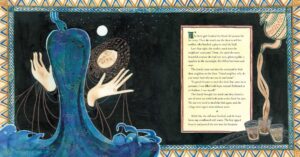 I should probably say something about Turk’s art itself. When I reviewed Grandfather Gandhi I had difficulty putting into words precisely what Turk does with his images. So I looked at the book’s professional reviews. His art causes reviewers to use terms like “dynamic visuals”, “stylized” and “strikingly patterned”. They say his art displays “bold, expressive imagery” or that he “mixes carefully detailed renderings with abstracted expressions of emotional struggle.” I agree with all of that but no one mentions his faces and hands. The patterns here are striking and upon closer inspection they yield such marvelous details it wouldn’t take much for this art to spin wildly out of control, opting for an abstract approach to the proceedings as a whole. Instead, Turk centers his art through the hands and faces of his characters. Look closely and you’ll see what I mean. The old storyteller’s hands are gnarled and wonderfully expressive, even as his audience of one clutches a single brass bowl. The hands of a cunning neighbor stroke her child as she schemes, while a princess, escaping on the night before her wedding, holds up her hennaed hands in despair. Hands. Heads. Hearts.
I should probably say something about Turk’s art itself. When I reviewed Grandfather Gandhi I had difficulty putting into words precisely what Turk does with his images. So I looked at the book’s professional reviews. His art causes reviewers to use terms like “dynamic visuals”, “stylized” and “strikingly patterned”. They say his art displays “bold, expressive imagery” or that he “mixes carefully detailed renderings with abstracted expressions of emotional struggle.” I agree with all of that but no one mentions his faces and hands. The patterns here are striking and upon closer inspection they yield such marvelous details it wouldn’t take much for this art to spin wildly out of control, opting for an abstract approach to the proceedings as a whole. Instead, Turk centers his art through the hands and faces of his characters. Look closely and you’ll see what I mean. The old storyteller’s hands are gnarled and wonderfully expressive, even as his audience of one clutches a single brass bowl. The hands of a cunning neighbor stroke her child as she schemes, while a princess, escaping on the night before her wedding, holds up her hennaed hands in despair. Hands. Heads. Hearts.
There’s been a lot of discussion lately about diversity in children’s literature. Specifically, some of that discussion has concerned those books written by white people about other cultures. It’s not a new phenomenon but what is a bit new is the increasing understanding that if you are going to use another culture, you need to do your homework. If, for example, you are setting a story in Morocco, then you need to make the readers understand why you made that choice. That it wasn’t arbitrary. This is yet another of the many reasons I’m so impressed with Turk’s work here. That he sets his story in Morocco (contemporary Morocco, by the look of it) is deeply purposeful. The Author’s Note at the end explains further. From this we learn that Morocco’s public storytellers or hlaykia have told tales for “nearly one thousand years” and yet “Only a handful of master storytellers remain”. All is not lost, though. Renewed interest in storytelling has surfaced, specifically at a restaurant called Café Clock in Marrakech. Turk then closes with a small Bibliography of sources on everything from storytelling to carpet weaving. The book then is not an appropriation of an “exotic” culture done on a whim but rather a considered, thoughtful selection that serves as an ideal setting for a tale about storytelling then, now, and in the future.
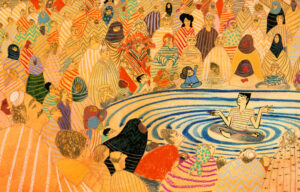 It was once part of a children’s librarian’s training to know how to tell a story from memory. Here in America it was even considered part of a children’s librarian’s heritage, though in the last few decades it has been fast forgotten. There are still pockets that remember, though. That’s why books like Turk’s give me the oddest little sense of hope. As I mentioned before, storytelling everywhere is seeing renewed interest. It seems odd to say, but this book, wrapped as it is in classic motifs and themes dating back hundreds, even thousands, of years, is one of the freshest, most timely picture books I’ve had the honor to read in a long time. Visually stunning with a storyline to match, Turk is beginning to make good on his talents. This is a man with storytelling in his blood and bones. Our children reap the rewards. A can’t miss book.
It was once part of a children’s librarian’s training to know how to tell a story from memory. Here in America it was even considered part of a children’s librarian’s heritage, though in the last few decades it has been fast forgotten. There are still pockets that remember, though. That’s why books like Turk’s give me the oddest little sense of hope. As I mentioned before, storytelling everywhere is seeing renewed interest. It seems odd to say, but this book, wrapped as it is in classic motifs and themes dating back hundreds, even thousands, of years, is one of the freshest, most timely picture books I’ve had the honor to read in a long time. Visually stunning with a storyline to match, Turk is beginning to make good on his talents. This is a man with storytelling in his blood and bones. Our children reap the rewards. A can’t miss book.
On shelves June 28th.
Source: F&G sent from publisher for review.
Like This? Then Try:
- Frederick by Leo Lionni
- Tell Me the Day Backwards by Albert Lamb, ill. David McPhail
- The Girl Who Saved Yesterday by Julius Lester, ill. Carl Angel
Misc:
See more images from the book here.

By:
Bianca Schulze,
on 3/21/2015
Blog:
The Children's Book Review
(
Login to Add to MyJacketFlap)
JacketFlap tags:
Roaring Brook Press,
Picasso,
Picture Books For Children,
Simon & Schuster Books for Young Readers,
Sharks,
Sally Wern Comport,
Rick Allen,
Princeton Architectural Press,
Ages 4-8,
Ages 9-12,
Picture Books,
Book Lists,
Non-Fiction,
Joyce Sidman,
Martin Luther King Jr.,
Gift Books,
featured,
Atheneum Books for Young Readers,
Eerdmans Books for Young Readers,
Katherine Applegate,
Knopf Books for Young Readers,
Gandhi,
Mary GrandPré,
Jen Bryant,
Melissa Sweet,
Alexander Calder,
Clarion Books,
Bethany Hegedus,
Bret Witter,
Angela Farris Watkins,
Barb Rosenstock,
Best Books for Kids,
Katherine Roy,
Best Kids Stories,
HMH Books for Young Readers,
Patricia Geis,
Arun Gandhi,
Evan Turk,
Luis Carlos Montalván,
David Macaulay Studio,
Dan Dion,
Add a tag
The best non-fiction picture books of 2014, as picked by the editors and contributors of The Children’s Book Review.

By:
Betsy Bird,
on 4/8/2014
Blog:
A Fuse #8 Production
(
Login to Add to MyJacketFlap)
JacketFlap tags:
Best Books of 2014,
Reviews 2014,
2014 reviews,
2014 biographies,
2014 nonfiction,
2015 Sibert contender,
2015 Caldecott contender,
Arun Gandhi,
Evan Turk,
Reviews,
nonfiction,
nonfiction picture books,
biographies,
Simon and Schuster,
Atheneum,
Best Books,
picture book biographies,
Bethany Hegedus,
Add a tag
 Grandfather Gandhi
Grandfather Gandhi
Arun Gandhi and Bethany Hegedus
Illustrated by Evan Turk
Atheneum (an imprint of Simon and Schuster)
$17.99
ISBN: 978-1-4424-2365-X
Ages 4-8
On shelves now.
Are you familiar with the concept of booktalking? It’s a technique librarians developed to get people interested in books they might otherwise not pick up. The whole concept is to develop a kind of movie trailer style talk that gives a sense of the book’s allure without giving up the plot. Typically booktalking is done for middle grade and young adult works of fiction, but enterprising souls have had a lot of luck with nonfiction as well. Now with an increased interest in nonfiction in our schools it’s more important than ever to make the books we hawk sound particularly good. It doesn’t hurt matters any when the books actually ARE good, though. Now let’s say I’m standing in front of a room of second and third graders with a copy of Grandfather Gandhi in my hands. How do I sell this book to them? Easy peasy. Some books practically booktalk themselves. Here’s how you sell it:
“Have any of you ever heard of Einstein? Yes? He’s the guy that was a total genius. Now imagine you’re his grandkid and you’re not that smart. Okay now, have any of you heard of the Beatles. Yes? Well imagine you’re one of THEIR grandkids . . . and you’re bad at music. Now here’s the big one. Has anyone heard of Gandhi? He was a great guy. He managed to free his country and stop a lot of oppression and he did it without any violence at all. Martin Luther King Jr. got some of his ideas from Gandhi about nonviolence. All right, well, now let’s image you are Gandhi, the most peaceful man IN THE WORLD’s grandson. What if you get mad? Can you imagine what it would be like to have everyone whispering every time you got a little steamed about something?”
So there you go. Quick. Simple. To the point. I’ve met a fair number of picture book memoirs in my day, but Grandfather Gandhi may well be my favorite. Smartly written with an unusual hook and art that will just knock your socks off, this is one title you are going to have to see firsthand for yourself.
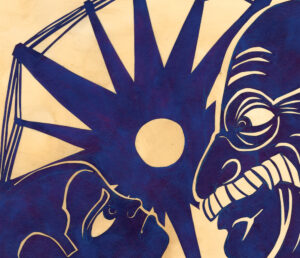 When young Arun and his family first arrive in his grandfather Mahatma Gandhi’s village, he’s mighty shy around his incredibly famous relative. Yet right away Grandfather is warm and welcoming to them, and when he praises Arun for walking the distance from the train station the boy swells with pride. Unfortunately, having Gandhi as your grandpa means having to share him with the 350 followers who also live in the village. Arun struggles with his lessons in Gujarati and the fact that there are no movie theaters around, but there are upsides to village life too. He’s pretty good at soccer with the other kids, and occasionally Grandfather will take him for a walk just mano a mano. But then, one fateful day, Arun gets into a skirmish on the soccer field and his anger is overwhelming. Shamed that the grandson of Gandhi himself would react in anger he confesses to his Grandfather immediately, only to find the man isn’t angry or disappointed in him in the least. Anger, Gandhi explains, is like lightning. You can use it to destroy or you can use it to light the world, like a lamp. Which will you choose?
When young Arun and his family first arrive in his grandfather Mahatma Gandhi’s village, he’s mighty shy around his incredibly famous relative. Yet right away Grandfather is warm and welcoming to them, and when he praises Arun for walking the distance from the train station the boy swells with pride. Unfortunately, having Gandhi as your grandpa means having to share him with the 350 followers who also live in the village. Arun struggles with his lessons in Gujarati and the fact that there are no movie theaters around, but there are upsides to village life too. He’s pretty good at soccer with the other kids, and occasionally Grandfather will take him for a walk just mano a mano. But then, one fateful day, Arun gets into a skirmish on the soccer field and his anger is overwhelming. Shamed that the grandson of Gandhi himself would react in anger he confesses to his Grandfather immediately, only to find the man isn’t angry or disappointed in him in the least. Anger, Gandhi explains, is like lightning. You can use it to destroy or you can use it to light the world, like a lamp. Which will you choose?
I think it’s fair to say that there have been a fair number of children’s picture books from family and relatives of famous peacemakers. Most notable would be Martin Luther King Jr.’s clan, where it sometimes seems like every son, daughter, niece, and nephew has his or her own spin on their infinitely famous relative. Gandhi’s a bit different. One wouldn’t expect his own descendants to have much in the way of access to the American publishing industry, so biographies of his life in picture book form have concentrated occasionally on his life and occasionally on The Great Salt March. When I saw that this book was co-authored by his fifth grandson I expected the same sort of story. A kind of mix of “this guy was fantastic” with “and I knew him!”. Instead, Hegedus and Gandhi have formulated a much more accessible narrative. Few children can relate to having a famous relative. But what about controlling their anger in the face of injustice? What’s fascinating about this book is that the authors have taken a seemingly complex historical issue and put it into terms so child-friendly that a five-year-old could get the gist of it. That Gandhi’s anger went on to become what spurned him to make lasting, important changes for his people is the key point of the book, but it takes a child’s p.o.v. to drill the issue home.
 Above and beyond all that, this is a book that advocates quite strongly for peace in all its myriad forms. Hardly surprising when you consider the subject matter but just the same I sometimes feel like “peace” is one of those difficult concepts without a proper picture book advocate. I went to a Quaker college where PAGS (Peace and Global Studies) was a popular major, and it was in making Quaker friends that I learned about picture books dedicated to the concepts embraced by that particular religion. Books like The Story of Ferdinand by Munro Leaf, The Table Where Rich People Sit by Byrd Baylor, Thy Friend, Obadiah by Brinton Turkle, and more. I’m sure that many is the Quaker household, or really any household that believes that peace is a practical and attainable solution, that will embrace Grandfather Gandhi as one of their own.
Above and beyond all that, this is a book that advocates quite strongly for peace in all its myriad forms. Hardly surprising when you consider the subject matter but just the same I sometimes feel like “peace” is one of those difficult concepts without a proper picture book advocate. I went to a Quaker college where PAGS (Peace and Global Studies) was a popular major, and it was in making Quaker friends that I learned about picture books dedicated to the concepts embraced by that particular religion. Books like The Story of Ferdinand by Munro Leaf, The Table Where Rich People Sit by Byrd Baylor, Thy Friend, Obadiah by Brinton Turkle, and more. I’m sure that many is the Quaker household, or really any household that believes that peace is a practical and attainable solution, that will embrace Grandfather Gandhi as one of their own.
It’s been a long time since I ran across a picture book with as long and lengthy a list of materials used in the illustrations as I have here. On the publication page it reads, “The illustrations for this book are rendered in watercolor, paper collage, cotton fabric, cotton, yarn, gouache, pencil, tea, and tin foil. Cotton hand spun on an Indian book charkha by Eileen Hallman.” Phew! You might think that all that “stuff” might yield something clogged up or messy, but that would be doing Mr. Turk a disservice. Observing how well he gives his pictures depth and texture, life and vitality, you might be shocked to learn that Grandfather Gandhi is his first picture book. From the spinning wheel endpapers to montages of sheer explosive anger, Turk makes a point of not only adhering to some of the more metaphorical aspects of the text, but finding new and creative ways to bring them to visual life. To my mind, the materials an artist uses in his or her art must, in the case of mixed media, have a reason for their existence. If you’re going to use “cotton fabric, cotton” and “yarn” then there should be a reason. But Turk clearly did his homework prior to doing the art on this book. He doesn’t just slap the images together. He incorporates the fibers Gandhi knew so well and turns them into an essential aspect of the book’s art. The art doesn’t just support the text here. It weaves itself into the story, becoming impossible to separate from the story.
 It’s Arun’s anger that proved to be the most visually interesting aspect, to me, in the book. Turk deftly contrasts the calm white thread produced by Gandhi’s spinning with the tangled black ones that surround and engulf his grandson whenever his feelings threaten to break free. The scene where he’s tempted to throw a rock at the boy who shoved him down is filled with thread, Arun’s magnificently clenched teeth, and black shadow figures that reach out across the field to the soccer net, dwarfing the three other little figures below. Later you can see the negative space found in cut paper turning from a representation of lightning into a thread of cotton in the hands of Gandhi illuminating a passage about making your anger useful. Yet Turk doesn’t just rely on clever techniques. He’s remarkably skilled at faces too. Arun’s expressions when he gets to see his grandfather alone or makes him proud are just filled with wide-eyed eager hope. And his frustrations and anger pulse off the page from his features alone.
It’s Arun’s anger that proved to be the most visually interesting aspect, to me, in the book. Turk deftly contrasts the calm white thread produced by Gandhi’s spinning with the tangled black ones that surround and engulf his grandson whenever his feelings threaten to break free. The scene where he’s tempted to throw a rock at the boy who shoved him down is filled with thread, Arun’s magnificently clenched teeth, and black shadow figures that reach out across the field to the soccer net, dwarfing the three other little figures below. Later you can see the negative space found in cut paper turning from a representation of lightning into a thread of cotton in the hands of Gandhi illuminating a passage about making your anger useful. Yet Turk doesn’t just rely on clever techniques. He’s remarkably skilled at faces too. Arun’s expressions when he gets to see his grandfather alone or makes him proud are just filled with wide-eyed eager hope. And his frustrations and anger pulse off the page from his features alone.
Picture books for kids about dealing with their anger tend towards the fictional. There’s Molly Bang’s When Sophie Gets Angry . . . Really Really Angry and Robie H. Harris’s The Day Leo Said, “I Hate You”. These are two of the good ones. Others veer towards the preachy and paternalistic. Imagine if you started using something like Grandfather Gandhi instead. More than just a memoir, the book offers a broad look at the benefits of channeling your anger. Better still, it’s a true story. Kids respect the true. They’ll also respect young Arun and his uncomfortable position. Fair play to author Bethany Hegedus for hearing him speak more than 13 years ago about this moment in his life, knowing that not only was there a picture book story to be had here, but a lesson kids today can grasp. As she says in her “Note from the Authors” at the end, “We world we live in needs to heal – to heal from the wars that are fought, to the bullying epidemic, to mass killings by lone gunmen, to poverty, to hunger, and to issues that contribute to internal anger being outwardly expressed in violent actions.” Gandhi’s message never grows old. Now we’ve a book that helps to continue his work for the youngest of readers. A necessary purchase then.
On shelves now.
Source: Final copy sent from publisher for review.
Like This? Then Try:
Other Blog Reviews:
Professional Reviews:
Interviews:
- ReaderKidZ speaks with Ms. Hegedus about the book.
- Meanwhile Kirkus interviewed the two authors and the illustrator here.
Misc: This is a book with a very nicely maintained and updated website of its own. Some of my favorite posts include this one from Evan Turk on how he got access to the spun cotton fiber featured in the book. I also light his piece on Light & Shadow and this one on how he chose his art. Arun even has posts up containing family Gandhi stories that would make an excellent follow up books should the need arise. Be sure to read the one on pumpkins and eggs when you get a chance.
Video:
One of the top best book trailers I’ve seen in a really long time. Accomplished and it does a brilliant job of highlighting Turk’s art.
llustration & Animation by Evan Turk
Voices: Arun Gandhi & Bethany Hegedus

 For a while there I enjoyed a little Reading Too Much Into Picture Books series before my Fuse 8 TV interviews. Very much along the same lines is the recent Salon piece Pat the Bunny Is Kind of Twisted and Other Lessons I Learned from Picture Books. It’s not the same three tropes garbled over and over again. There’s a lot of smart stuff being said here. Enjoy!
For a while there I enjoyed a little Reading Too Much Into Picture Books series before my Fuse 8 TV interviews. Very much along the same lines is the recent Salon piece Pat the Bunny Is Kind of Twisted and Other Lessons I Learned from Picture Books. It’s not the same three tropes garbled over and over again. There’s a lot of smart stuff being said here. Enjoy! Um… so this one has nothing to do with children’s books and everything to do with my own childhood. Basically, if you’ve been waiting for an article to justify Lady Elaine Fairchilde as the feminist icon she truly was, your prayers have been answered. Extra Bonus: Check out the perhaps indeed legit comment from Lady Aberline. Or read my piece on the new Lady Elaine. Clearly this is a trope in my life.
Um… so this one has nothing to do with children’s books and everything to do with my own childhood. Basically, if you’ve been waiting for an article to justify Lady Elaine Fairchilde as the feminist icon she truly was, your prayers have been answered. Extra Bonus: Check out the perhaps indeed legit comment from Lady Aberline. Or read my piece on the new Lady Elaine. Clearly this is a trope in my life.


















The links to support Carla Hayden include an Illinois address rather than the generic page.
Oo! Looking into it. Thanks for the catch.
CHALLENGE: ACCEPTED
One
Oct 1, 2008
by Kathryn Otoshi
Two
Sep 23, 2014
by Kathryn Otoshi (is this cheating?)
The True Story of the Three Little Pigs
Mar 1, 1996
by Jon Scieszka and Lane Smith
The Fourth of July Story
Jun 1, 1995
by Alice Dalgliesh and Marie Nonnast
Five Minutes’ Peace (Large Family)
Jul 7, 2016
by Jill Murphy
Now We Are Six (Winnie-the-Pooh)
Aug 1, 1992
by A. A. Milne and Ernest H. Shepard
Seven Blind Mice
Mar 15, 2012
by Ed Young
8: An Animal Alphabet
Jul 28, 2015
by Elisha Cooper
Nine O’Clock Lullaby
May 30, 1993
by Marilyn Singer and Frane Lessac
Ten Black Dots
Sep 21, 1995
by Donald Crews
11 Experiments That Failed
Sep 27, 2011
by Jenny Offill and Nancy Carpenter
The Twelve Dancing Princesses
Nov 12, 2009
by Rachel Isadora
You may have just jettisoned to become my favorite person of all time.
’tis but a trifle.
But now I really want to make the damn thing!